 |  |
One day there was Bob the gorilla. He was in the Rolla zoo. After his breakfast of lettuce, he beat the zookeeper with a smaller monkey because the marginal utility of hitting the zookeeper with the larger monkey was not proportionally greater than the price. While the zookeeper was unconscious, Bob stole his keys, which were not a free good, because Bob could have been doing something else with his time, such as scratching his armpit (the average marginal utility of the keys divided by the price [which is the utility of scratching] was greater than the marginal utility of the scratching divided by the price. This is equal to the area under the supply curve of Bob's time between the points of equilibrium of scratching and equilibrium of beating the zookeeper with a larger monkey minus the area under the supply curve for keys between the equilibrium point of lettuce and the equilibrium point of larger monkeys.). 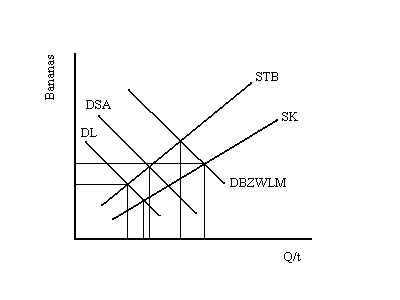 So, having escaped, he decided to do something he couldn't do at the zoo, such as extreme sports. The most appealing of these ultra-fun extreme sports to Bob was "random surgery." The marginal utility of the surgery for Bob (denoted MURSB) must have been greater than the price, because he decided to do it. The price however, was very low because the demand curve for random simian organs was high enough because of scarcity and elastic enough to make the surgeon's marginal benefit of selling the primate parts higher than the marginal cost. Therefore, the marginal product of labor for the production of simian organs (denoted MPLPSO) was below the average variable cost curve plus the average fixed cost. Although this was true, the curve did not have a high enough marginal product of labor to increase the scale of production because that would result in a diseconomy of scale.
Once the transaction was complete, Bob had to use the little monkey's room. When he got there, he discovered what set of muscles the doctor had removed. Bob couldn't "go!" Apparently, the doctor had a trade relationship set up with some other doctor who had a comparative disadvantage in the production of simian rectal muscles that allowed both participants to consume goods at a point outside their production-possibilities-frontier (see graphs). This free-trade setup resulted in lower prices for consumers and lower marginal production costs for the sellers; however, even the lack of supply-shifting tariffs or quotas couldn't help Bob the gorilla. 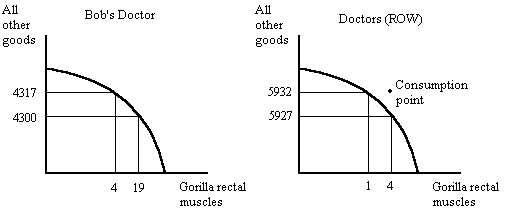 So on his way out of Wal-Mart, Bob picked up some laxatives. The price was very high, resulting in the shifting of the equilibrium point on the demand curve toward the lower end because of the elasticity of the demand curve for the general population. However, Bob's demand curve was very inelastic, so his demand for the product didn't fall any considerable amount. He didn't have any money, he left his checkbook in his other fur, so he just walked out with it (besides, he didn't know about the checkout anyway). This wasn't a free good either, because Wal-Mart to pay for the laxatives, which raised the price for every other consumer, albeit by such a small amount it wasn't noticed by many.
While walking through the parking lot, Bob was kidnapped by a car-jacker (coincidentally also named Bob. However, he wishes to remain anonymous, and will be referred to as such for the rest of the problem.). At first Bob didn't realize he was being kidnapped, because ski masks and handguns are complimentary goods, and as the price of handguns goes up, the demand for ski masks goes down, and the car-jacker wasn't able to afford both. However, once Bob realized that the car-jackers marginal utility of holding a gorilla hostage will not continue to increase as fast as the marginal price of driving a stolen car, he knew he had to do something fast. But he didn't know what to do, so, after taking some laxatives and politely offering some to the car-jacker, he took a nap. The car-jacker refused the offer because his marginal utility of taking laxatives divided by the price would not exceed the marginal utility of driving with clean britches divided by the price of foregone laxatives offered by aforementioned ape. 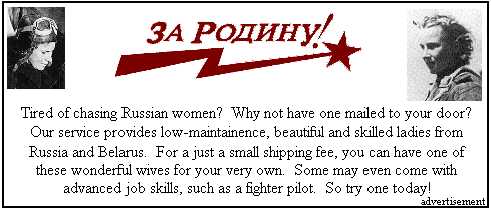 When Bob's over-exerted intestinal tract started making gurgling noises, it woke him up. The car-jacker was startled because he had forgotten about the gorilla because the car was upholstered in black shag, and Bob blended in. The startled would-be felon fired a shot in the direction of the movement because, being a safe driver, he didn't see fit to look away from the road to aim. This means that the car-jacker's marginal utility of aiming at the gorilla divided by the opportunity cost of driving (MUAG/POCD) did not exceed the marginal utility of not dying in a car crash divided by the opportunity cost of shooting accurately at a constipated ape (MUNDCC/POCSAACA). So the car-jacker missed, but it scared the poop out of Bob, which solved one problem. The sudden decrease of pressure inside of Bob and the sudden increase of pressure in the car and the diffusion of bad-smelling gas molecules caused the car-jacker to lose his concentration on the road, and his consciousness.
The car veered off the road, through a barrier and off a cliff into the ocean. Some students at UMR saw the incident while fishing and one went to call 4300 at nearby Castleman Hall while the others dove in to save whoever they could. The car was steel because the marginal cost of steel is lower than the marginal cost of plastic and the marginal product of labor for steel workers (MPLSW) is greater for steel workers than the marginal product of labor for plastic production engineers (MPLPPE). Because the car was heavier than water, it sank. Unfortunately, all the remaining students were Econ majors, and couldn't engineer a way to rescue the passengers. Had there been any Naval engineers with a minor in Auto engineering, the car-jacker may have been saved.
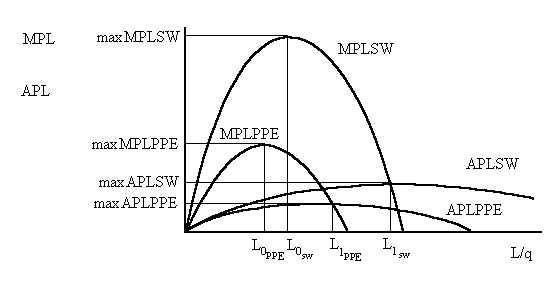 Bob the gorilla was strong though, and broke out of the car and swam to the surface. So, alive and clean, he decided that he was hungry. Yes, eating will renew the need to void himself, but the marginal utility of eating divided by the opportunity cost of starving to death was greater than the marginal utility of never having to "go" again divided by the opportunity cost of a good dinner. Besides, if he needed to "go" again, he could just get car-jacked again.
Now Bob needed to decide where to eat. So he graphed the marginal utility of each restaurant (and soup kitchen) against the price of the respective establishments, and from there determined the best restaurant at which to eat. The place with the highest marginal utility of all was, of course, the TJ Cafeteria, which incidentally had the lowest price if he pretended he had a Carte Blanche meal plan. Upon trying to get in, the card scanner mistook him for a football player on one of Rollas rival teams and started beating him on the head with a cafeteria tray while Bill threw ice cream sandwiches at him. 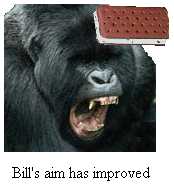 This reduced the marginal utility of the TJ Cafeteria, although it did give him some relatively low-cost ice cream sandwiches. He was an upstanding, independent ape, and so refused to go to a soup kitchen. After much deliberating, he decided upon Sirloin Stockade because he felt like eating a good hearty steak.
Once inside however, he discovered the high price of a fine wine to go with his steak. All he could afford was the White Zinfandel, but he really needed a red wine for a rare steak. Because wine and steak are compliments, the demand for steak went down considerably. This would have forced Bob to eat something else, perhaps the baked potatoe (guess who is his great-uncle).
As Bob dejectedly sighed, he noticed a middle aged man (in a snazzy suit and sneakers) eating a steak at the table next to him. The man was having a conversation with the waiter about the sun and the stellar abundance of the elements. Bob the gorilla had always been interested in astrophysics, so this caught his attention. As the man enlightened Bob about how the sun is made of iron and the hydrogen just floated to the top like the skin of an apple, an idea formed in that little simian brain. If all that hydrogen was really just bunkum, then what could he do with all that iron? Bob wanted to start a mine on the sun! He quickly calculated the fixed cost of building a launching pad (FCBLP), the average variable cost of transporting the equipment to the sun and the iron back (AVCTETSAIB). He sketched the following graph on a napkin: 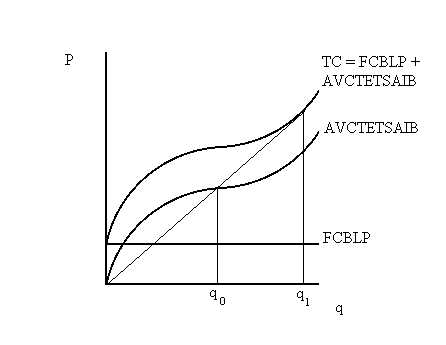 Bob realized just how much that kind of mining operation would cost. As he looked at the curves and reminisced about that big hairy she-ape he shared a cage with last year, he decided that he needed to know how much iron would have to be mined to make up for the fixed cost. He tried to imagine the demand curve for iron in relation to the supply curve for his operation and for the rest of the solar system, but the only curves he could imagine were really hairy. He had to see something on paper. So he drew the following graph: 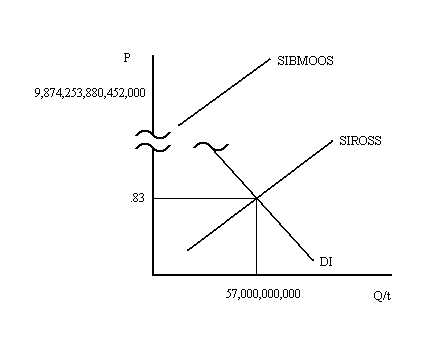 Seeing this graph confirmed his suspicions: he would have to sell an amount of iron more massive than the earth itself to make a profit on this endeavor. Being disappointed made him mad, and when Bob the gorilla is mad, he wants blood. So he went back into the kitchen, trying to look nonchalant. Being mistaken for a chef, he managed to get all the way to the meat freezer, where he chose the best steak and proceeded to eat it raw. He did not cook it because the marginal utility of cooking the steak divided by the opportunity cost of eating another raw steak was lower than the marginal utility of eating two raw steaks divided by the opportunity cost of scratching himself again. He never actually got to drink the wine, because he was under 21, and he didn't want the embarrassment of being carded.  So Bob the gorilla wandered about town, looking for a drink. As he entered the local Arby's, a man in overalls, a John Deere hat, and a beard came up to him kissed him and said "Honey, where've ya been?" Bob did not go for that inter-species kind of thing, besides he was a male monkey, and he didn't go for that kind of thing either. As he slowly backed off, a woman in overalls, a John Deere hat, and a beard came up and punched the man. They proceeded to argue about why he was cheating on her with a prettier woman, and how he had mistaken the two and she should feel complimented that he mistook such a beautiful woman to be his wife, etc... So Bob tried to leave that situation by ordering a famous Arby's chocolate shake. What he got however, was a glass of white milk. Since that did not provide the marginal utility he was expecting, he took it back.
The freshman working there explained that all the shakes were like that because the marginal benefit of repairing the shake machine did not exceed the marginal cost of the repairman (whose sum of fixed cost and average variable cost as a function of time was greater than the supply/demand equilibrium point) and the parts. As Bob was starting to knuckle-shuffle away disappointed, the counter guy looked over at the brawling couple, back at Bob, and muttered something about "all the townies are alike..." 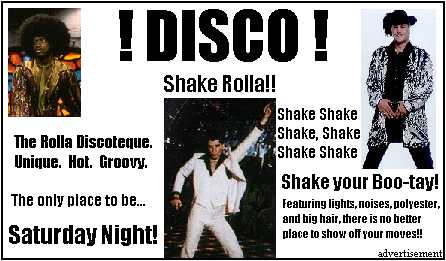
Still looking for a good time, Bob wandered toward the part of Rolla with the most neon lights: downtown dance club lane. Remembering an ad in a well-written publication about microeconomics a benevolent businessman once threw in his cage, Bob decided to go for the Rolla Discoteque. Once inside however, he was confronted by another gorilla! This one spoke, and invited him inside for the CCF disco party. Now Bob didn't dislike the people from CCF, but there was another gorilla there. It would vastly reduce Bob's marginal utility of dancing (MUD) to have another gorilla present (he liked being unique) and his opportunity cost of scratching was steadily increasing. Although he could scratch himself anywhere and still call it disco dancing, he was a modest ape.
Concluding that there is nothing fun to do in Rolla (except random surgery, but Bob had partaken all he could stand of that particular diversion) Bob decided that he would try to go elsewhere. Now, when a gorilla wants to go somewhere, he wants to go in style. Bob was no exception, in fact he was a rather stylish chap himself. But what could he use?
He could "borrow" a car, but nobody at Rolla had any stylish cars. Confounded, Bob had almost resigned himself to staying in "The middle of everywhere" when, just at that precise moment, the Red Angels roared overhead! For those of you who are unfamiliar with them, the Red Angels are the Russian daredevils, analagous to the Blue Angels. Bob's problem was solved!
Now all he had to do was figure out why in the world a squadron of Russian fighter jets was flying over the Central United States. Of course, the airshow the UMR Air Force ROTC puts on every year! In fact, that was probably the freshmen flying the jets (initiation, you know). If only the freshmen were working security as well...
So Bob decided to follow the jets to wherever they were based. This was a difficult task, as they flew at several hundred miles an hour, but Bob had very muscular legs and eventually arrived at the airfield. By this time, he was tired and didn't feel like sneaking anywhere, so he just threw everyone out of the way until he got to the jets that were ready for takeoff. It was there amid the crowds of frightened onlookers and savage security guards that Bob fell in love with the MiG-29.
Cheesy music played in the background of his mind while he slowly inched his way to the terrified pilot standing on the ladder leading up to the cockpit. Quickly realizing that his marginal utility of standing on the ladder and getting thrown through the crowd by an enamored gorilla divided by the opportunity cost of wetting his pants and running away to get court martialed for losing an expensive jet (MUSLGTTCBEG/POCWPRAGCMFLEFJ) was not proportionally greater than the alternative, the airman quickly fled. Bob the gorilla was a smart ape, and he knew it. However, he was also a bit headstrong and cocky. Someday, it may even be his downfall, but not right now. As he hopped in the cockpit, he knew nothing about the controls, but was confident in his abilities to learn quickly. How does one learn the controls of a multitrillion ruble air superiority fighter? Play with the levers and buttons, of course!
Bob proceded to do so, with the utmost respect for the high-tech machinery and the scientific method. In other words, he grabbed the biggest red lever he saw, which happened to be the lever on the left side of the cockpit. As everyone knows, this is the throttle; as it is pushed forward the jet goes, and go it did. So quickly in fact, that Bob was knocked off his feet into the seat. This threw him into a panic, and he randomly started hitting buttons (which, incidentally, is NOT how to learn how to fly a MiG-29).
However, once he got into the air, an overwhelming sense of calm overtook him. Like a sea of placidity lapping away at his fears, the gentle landscape rolling below him washed away his concerns and Bob assumed the yoga meditation pose.
Then he hit the South tower of Thomas Jefferson Residence Hall.
This, of course, was not good for the plane. It was only a glancing hit, and didn't instantly obliterate the jet, as one would expect from a direct collision. It only ripped out a portion of the upper fuselage (because the jet was upside-down at this point, remember the yoga?). As one nears death, the senses are heightened, time slows, and the strangest things seem significant. For instance, Bob thought he noticed part of a dismembered mouse stuck on one of the windows of the South tower.  The most convenient things happen when time slows down like that, such as being able to hit the eject button, which Bob did with all due rapidity. However, since he was not strapped in, he just flew out with the cockpit and didn't get the benefit of the parachute.
That didn't matter though, because the 7 Northers had flown a kite (cleverly made of a Wal-Mart sack) from the balcony. Bob was able to grab onto this and swing down to land in the swimming pool. Thus safely landing, Bob reviewed his near-death experience.
As fun as that was, and as good a pilot as he was (surely as good as Chinese pilots), Bob decided he would try another random surgery before trying another MiG theft. Bob the gorilla knew the police must be after him by now (the state troopers, the Rolla cops were still on their way to the cliff to investigate the reported drowning), so he decided that he must take a drastic step. He went to the hippest clothing store in Rolla, Wal-Mart. He could have gone to the army surplus store, but he didn't look good in camouflage, and besides, he didn't to be mistaken for a guerilla (how embarrassing that would be). So, hiding among a group of unshaven CompSci majors, he snuck in the front door, then broke away and stole toward the clothing section. He decided that the marginal utility of disguising himself in Abercrombie and Fitch clothes divided by the price in opportunity cost of scratching (MUDBA&FC/POCS) was greater then the marginal utility of the excitement of a struggle and brief firefight with the police divided by the price in opportunity cost of living to scratch (MUESBFWP/POCLS). 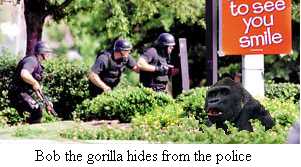 Donning a ball cap, a sweatshirt, and cargo pants all by Abercrombie and Fitch, he realized that he needed shoes, because his feet looked like his hands. However, he didn't know what shoes went with the A&F clothes. Then he realized that the marginal utility of living naked in the zoo with the ability to poop divided by the price in opportunity costs of beating the zookeeper with a monkey, stealing the keys, escaping, playing extreme sports (random surgeries), getting kidnapped, eating steak, getting sexually harassed by a guy in coveralls, disco dancing, and stealing trendy clothing (MULNZWATP/[POCBZWM+POCSK+POCE+POCPXSRS+POCGK+POCES+POCGSHBGIC+POCDD+POCSTC) was greater than the marginal utility of wearing Abercrombie and Fitch clothes divided by the price of having to worry about what shoes to wear plus the opportunity cost of scratching (MUWA&F/PHWAWSTW+OCS).  So Bob the gorilla decided to return to the zoo, where he could enjoy pooping again. On his way back, he remembered the marginal utility of scratching, and decided to do it right there. However, he made a mistake, because the marginal utility of scratching divided by the price in opportunity cost of crossing the rest of the road (MUS/POCCROR) was significantly less than the marginal utility of not getting smeared all over the highway divided by the price in opportunity cost of stopping to scratch (MUNGSAOH/POCSTS).
Upon realizing his error in judgement, Bob the gorilla broke out of his scratching reverie and quickly looked both ways. Luckily for him, there was no one coming either way. He decided to finish getting across the street, but before he could get across, he was run down by, coincidentally, someone on her way to see another Bob, this one a tomato. The reckless driver was not injured in this hit-and-run accident, and her car was not damaged beyond a broken rear view mirror. It is doubtful if she even realized that she had run down the only primate with a complete understanding of microeconomics.
To make sure you understand the concepts presented in this text, here is a self-evaluation you can have someone give you:
1. Why was the zookeeper in Bob's cage in the first place?
2. What kind of neutrinos are produced by fusion in an iron-core star?
3. Why does Bob have a soccer ball?
4. What size pants does Bob wear?
5. Which Mexican avocados are diseased?
|



